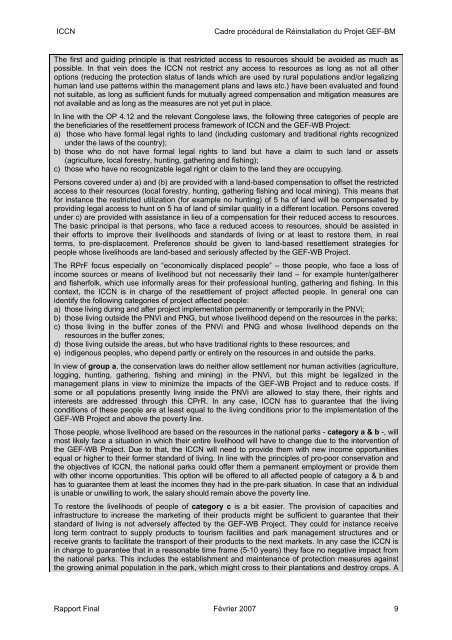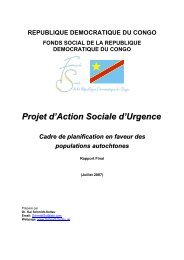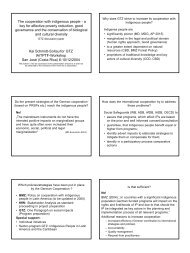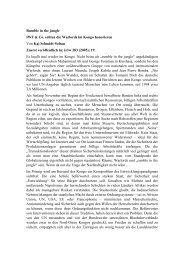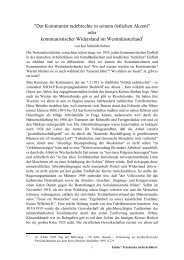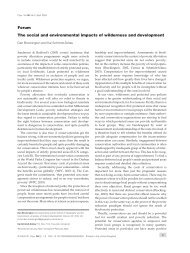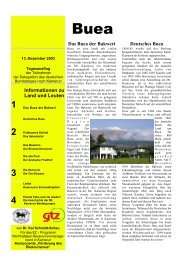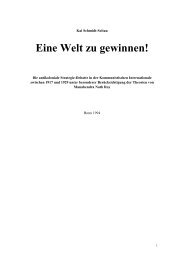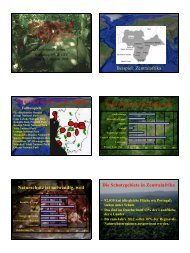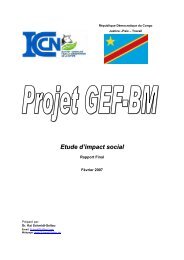Cadre Procédural de Réinstallation - Dr. Kai Schmidt-Soltau
Cadre Procédural de Réinstallation - Dr. Kai Schmidt-Soltau
Cadre Procédural de Réinstallation - Dr. Kai Schmidt-Soltau
You also want an ePaper? Increase the reach of your titles
YUMPU automatically turns print PDFs into web optimized ePapers that Google loves.
ICCN<br />
<strong>Cadre</strong> procédural <strong>de</strong> Réinstallation du Projet GEF-BM<br />
The first and guiding principle is that restricted access to resources should be avoi<strong>de</strong>d as much as<br />
possible. In that vein does the ICCN not restrict any access to resources as long as not all other<br />
options (reducing the protection status of lands which are used by rural populations and/or legalizing<br />
human land use patterns within the management plans and laws etc.) have been evaluated and found<br />
not suitable, as long as sufficient funds for mutually agreed compensation and mitigation measures are<br />
not available and as long as the measures are not yet put in place.<br />
In line with the OP 4.12 and the relevant Congolese laws, the following three categories of people are<br />
the beneficiaries of the resettlement process framework of ICCN and the GEF-WB Project:<br />
a) those who have formal legal rights to land (including customary and traditional rights recognized<br />
un<strong>de</strong>r the laws of the country);<br />
b) those who do not have formal legal rights to land but have a claim to such land or assets<br />
(agriculture, local forestry, hunting, gathering and fishing);<br />
c) those who have no recognizable legal right or claim to the land they are occupying.<br />
Persons covered un<strong>de</strong>r a) and (b) are provi<strong>de</strong>d with a land-based compensation to offset the restricted<br />
access to their resources (local forestry, hunting, gathering fishing and local mining). This means that<br />
for instance the restricted utilization (for example no hunting) of 5 ha of land will be compensated by<br />
providing legal access to hunt on 5 ha of land of similar quality in a different location. Persons covered<br />
un<strong>de</strong>r c) are provi<strong>de</strong>d with assistance in lieu of a compensation for their reduced access to resources.<br />
The basic principal is that persons, who face a reduced access to resources, should be assisted in<br />
their efforts to improve their livelihoods and standards of living or at least to restore them, in real<br />
terms, to pre-displacement. Preference should be given to land-based resettlement strategies for<br />
people whose livelihoods are land-based and seriously affected by the GEF-WB Project.<br />
The RPrF focus especially on “economically displaced people” – those people, who face a loss of<br />
income sources or means of livelihood but not necessarily their land – for example hunter/gatherer<br />
and fisherfolk, which use informally areas for their professional hunting, gathering and fishing. In this<br />
context, the ICCN is in charge of the resettlement of project affected people. In general one can<br />
i<strong>de</strong>ntify the following categories of project affected people:<br />
a) those living during and after project implementation permanently or temporarily in the PNVi;<br />
b) those living outsi<strong>de</strong> the PNVi and PNG, but whose livelihood <strong>de</strong>pend on the resources in the parks;<br />
c) those living in the buffer zones of the PNVi and PNG and whose livelihood <strong>de</strong>pends on the<br />
resources in the buffer zones;<br />
d) those living outsi<strong>de</strong> the areas, but who have traditional rights to these resources; and<br />
e) indigenous peoples, who <strong>de</strong>pend partly or entirely on the resources in and outsi<strong>de</strong> the parks.<br />
In view of group a, the conservation laws do neither allow settlement nor human activities (agriculture,<br />
logging, hunting, gathering, fishing and mining) in the PNVi, but this might be legalized in the<br />
management plans in view to minimize the impacts of the GEF-WB Project and to reduce costs. If<br />
some or all populations presently living insi<strong>de</strong> the PNVi are allowed to stay there, their rights and<br />
interests are addressed through this CPrR. In any case, ICCN has to guarantee that the living<br />
conditions of these people are at least equal to the living conditions prior to the implementation of the<br />
GEF-WB Project and above the poverty line.<br />
Those people, whose livelihood are based on the resources in the national parks - category a & b -, will<br />
most likely face a situation in which their entire livelihood will have to change due to the intervention of<br />
the GEF-WB Project. Due to that, the ICCN will need to provi<strong>de</strong> them with new income opportunities<br />
equal or higher to their former standard of living. In line with the principles of pro-poor conservation and<br />
the objectives of ICCN, the national parks could offer them a permanent employment or provi<strong>de</strong> them<br />
with other income opportunities. This option will be offered to all affected people of category a & b and<br />
has to guarantee them at least the incomes they had in the pre-park situation. In case that an individual<br />
is unable or unwilling to work, the salary should remain above the poverty line.<br />
To restore the livelihoods of people of category c is a bit easier. The provision of capacities and<br />
infrastructure to increase the marketing of their products might be sufficient to guarantee that their<br />
standard of living is not adversely affected by the GEF-WB Project. They could for instance receive<br />
long term contract to supply products to tourism facilities and park management structures and or<br />
receive grants to facilitate the transport of their products to the next markets. In any case the ICCN is<br />
in charge to guarantee that in a reasonable time frame (5-10 years) they face no negative impact from<br />
the national parks. This inclu<strong>de</strong>s the establishment and maintenance of protection measures against<br />
the growing animal population in the park, which might cross to their plantations and <strong>de</strong>stroy crops. A<br />
Rapport Final Février 2007 9


